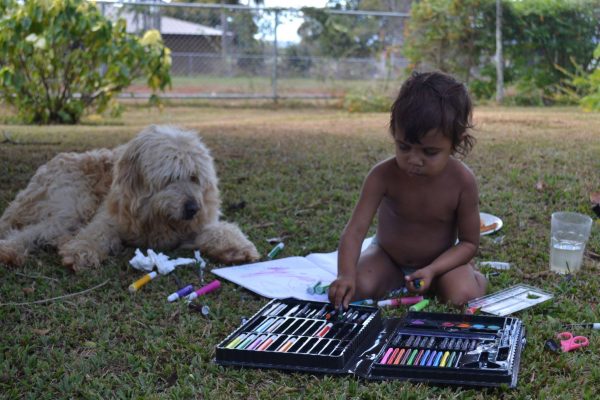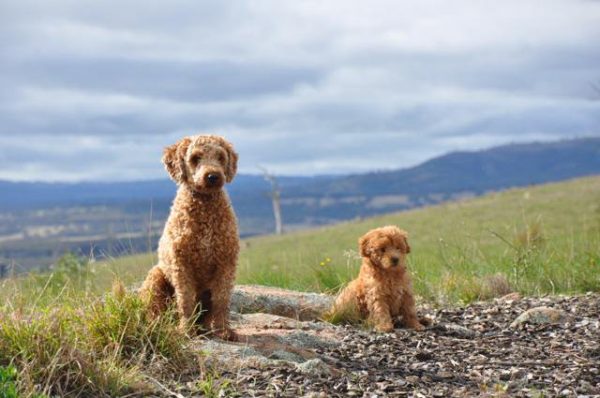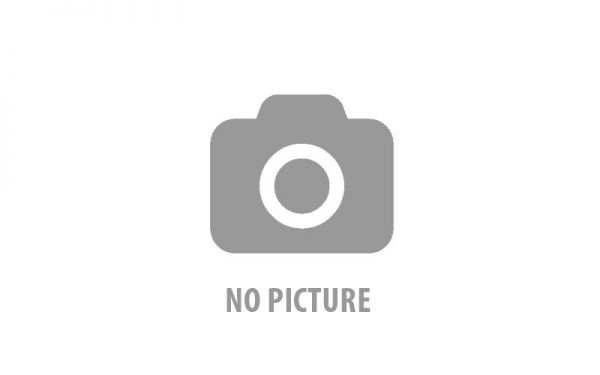People do wacky things when it comes to grooming dogs, changing the shape, colour and even species of the animal.
We prefer to keep the hair the same length all over, so that the dog is still recognisable after the trim. Take for example, our dog Morrie. Here’s a photo of him with his full coat, taken while his was living with my daughter Lizzy in Far North Queensland:

This is a photo of Morrie after Lizzy took to him with a pair of scissors (apparently they don’t have clippers in remote communities):

It may not be the world’s best haircut, but she’s got the message. Morrie is still recognisably Morrie.
Here’s my daughter Jane’s dog, Ridgey, pictured here with his father Rufous – our very curly poodle, who is a very fine looking dog and beautifully proportioned (…at least I think so, but he is my dog).

And here is one Jane’s photos of Ridgey a year later, after a clip:

While I do NOT condone the jumper (she looks ridiculous!) the haircut is fine – Ridgey still looks like Ridgey.
Here’s another photo of Ridgey, this time with a shorter cut. She still looks like a normal (if not so absurdly cute) dog in this photo with Brown and Rufous, sitting for some sausage (they always sit beautifully in the kitchen). Ridgey’s hair is growing back evenly and in a few months she will be as cute as ever, although I don’t think my daughter Jane will let me near her again with clippers:

These three are a Backcross labradoodle, a Groodle and a purebred Poodle – all very different in size and coat types – but they don’t look all that different from each other. How your dog looks like when fully grown will depend on its haircut.
So if you want your dog to look as much like a real dog as possible how should you cut their hair?
This is how we do it – this is Lily getting her very overdue first haircut:

It’s a bit radical – we use number 10 clippers (a close shave) and take off the whole coat three times a year, in the spring, early summer and mid autumn. By spring they look like woolly bears and we start all over again. Between clips and in mid winter we trim their eyes – across the bridge of the nose to remove the hair that can obscure their vision or sometimes rub in their eyes. You need to do this regularly with a long pair of scissors so you can’t accidentally stab your dog in the eye.
You don’t need to be as radical as we are. Size 3 clipper blades will leave a short coat which is much more attractive than our bald dogs. If you want to leave more hair than this then you will either have to groom your dog very thoroughly before the clip or pay for dematting their coat before they can be clipped with an extension comb or spacer. The trick to keeping your dog looking normally proportioned is to ask that they use the same length blade all over. Shave across the nose under the eyes, and shave under the ears, don’t shave the nose and otherwise NO LONGER BITS.
This first puppy clip is perfect, in my never humble opinion. No long spaniel looking ears, no mutton chop whiskers and I will even overlook the bow!

On a slightly more serious note it’s not all about looks. The long hair on their ears will make their ears heavier and may exacerbate the predisposition to ear problems which are common in all dogs with drooping ears. The whiskers on the face are going to get wet and grotty when they get in the food …. If you really must – feel free to leave the feathers on the tail – I can’t think of a serious reason why they can’t stay.
